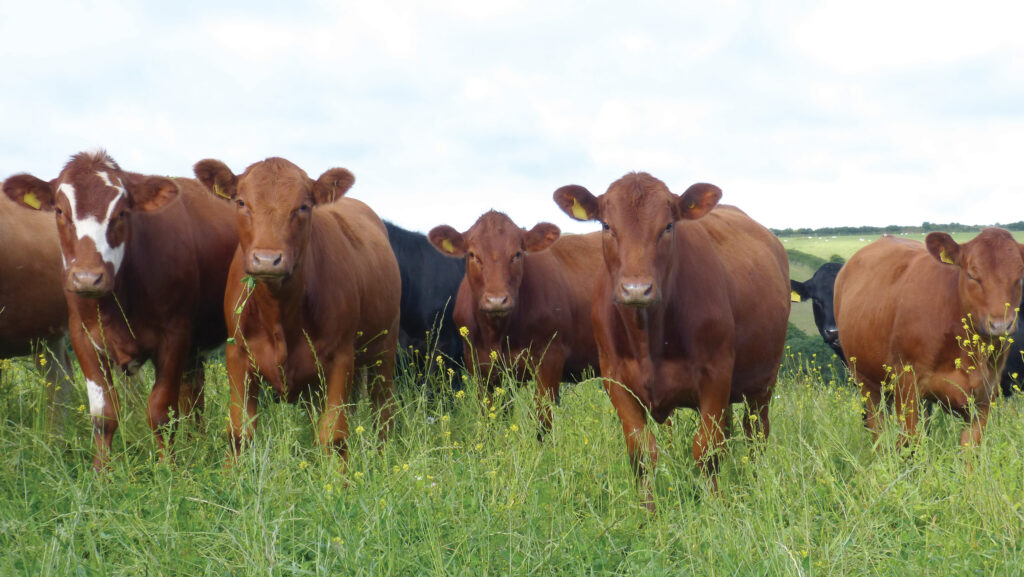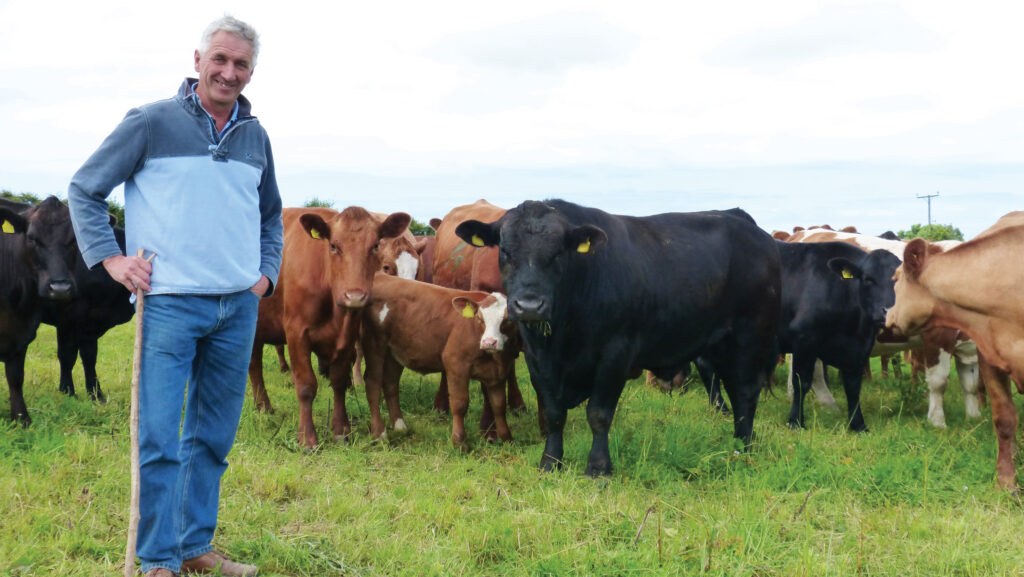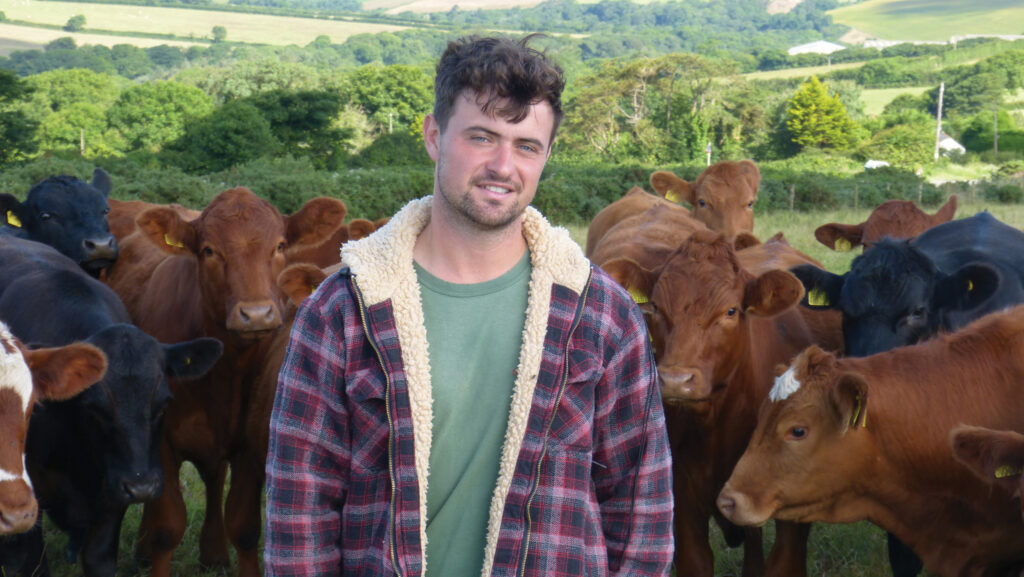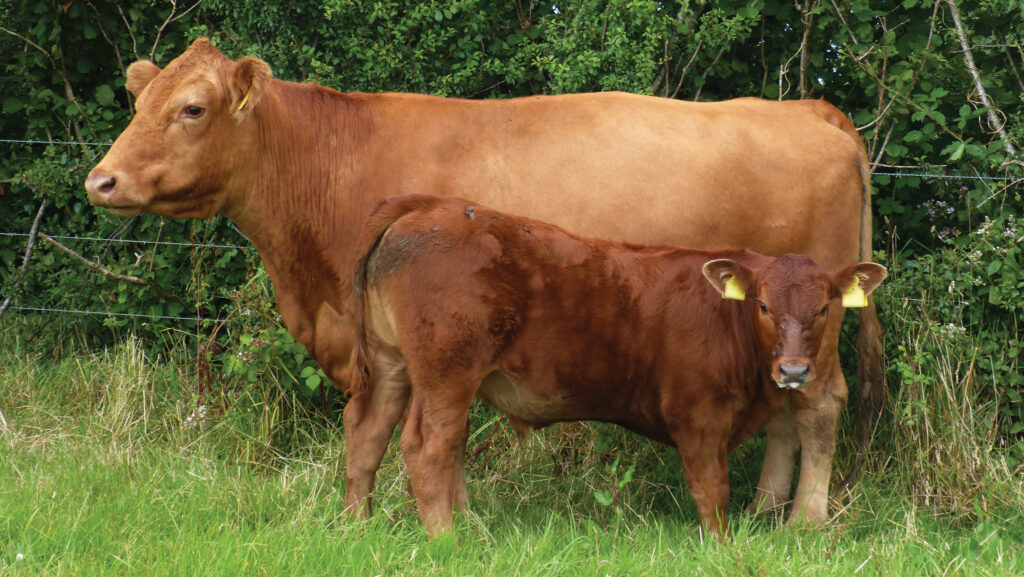Suckler business lifts margin £353/ha with fewer cows
 R2 heifers at Blable farm © MAG/Michael Priestley
R2 heifers at Blable farm © MAG/Michael Priestley Gross margins are 71% higher on a Cornish suckler unit after cutting cow numbers to help tackle wintering costs and increase pasture rest periods.
Five years ago, the Roberts family planned to take 60ha of land back in hand from vegetable growers and increase their herd from 180 to 250 cows at Blable farm, Wadebridge.
At the time, letting out ground for potatoes, vegetables and maize was useful cashflow. The plan was to dilute costs by increasing cow numbers.
See also: Video: Outwintering system hopes to beat £163 a cow savings
Blable farm facts
- 145 Stabiliser cows bred to a North Devon, an Angus and three Stabilisers
- 186ha all as grazed or silage grass, of which 140ha ploughable
- Calving at 24 months
- Supplying Kepak deadweight
- 500kW wind turbine
- Two residential and three holiday lets
- Farm Net Zero Demo Farm
Farm history
Mike’s grandparents bought Blable in 1948. He took over in the 1990s, running 550 commercial ewes, 150 dairy cross beef cattle, 90 Limousin and Blonde cross sucklers and 40ha of arable.
He sold the sheep in 2002, bought his first Stabiliser bull in 2005 to increase growth rates with hybrid vigour and soon found calving and handling was easier.
The combine was sold in 2011, making the farm all grass and allowing herd size to reach 220-head by 2014.
However, that year a wind turbine was installed, so cow numbers fell to 120 and 60ha of ground was rented out to help raise capital. Shed building then started to rebuild to 250 cows.

Mike Roberts © MAG/Michael Priestley
Grazing advice
Poor grass growth in 2019 limited the growing cattle to just five months of grazing, which severely impacted profitability.
This made the Roberts call on the services of local grazing consultant James Daniel of Precision Grazing.
“I wasn’t keen on the idea of moving fences at first,” says Mike. “But after the summer of 2019 we knew change was needed.”
James asked Mike and son Sam three key questions to develop a system that suited the family’s aims:
- What are your costs? James calculated a margin of £26 a cow (before subsidy and labour costs) was being achieved.
- What do you want from your farm? Mike and Sam both wanted a better work-life balance. Sam dislikes tractor work. Sam is a keen rugby player, footballer and enjoys skiing.
- Where do you see yourself in 10 years? Mike wanted more time to pursue other interests and run an easier farming system with just family labour, and achieve a smooth succession plan, handing the reigns to Sam.
Herbal ley
James suggested turning 70 steers onto 9ha of autumn sown herbal ley on 1 March 2020. This field was split into nine 1ha paddocks.
Sections of 25mm pipe were dug in to feed three concrete water troughs to create a three-day move.
The ley was established with compost, dung and a small dressing of fertiliser, but no fertiliser thereafter. Cattle gained 1.2kg a day until November housing and some paddocks yielded bales.
“It was a lightbulb moment. We saw the value of diverse leys, clover, and electric fencing,” says Sam.
Rather than rebuilding cow numbers, the next change was to cut cow numbers further by 30 to 150-head, to reduce silage and fertiliser requirements.
Water troughs were fitted in the middle of fields and fencing reels and energisers were bought, meaning one pasture could become four or eight paddocks, and by the summer of 2021, the cows and calves were on 1ha paddocks moved every two days.
Youngstock are now outside for 18 months until they are housed to finish and now all cattle are finished at Blable, whereas previously stores were offloaded because grass was short most summers.

Sam Roberts © MAG/Michael Priestley
Wintering
Spurred on by their success, wintering fields were subdivided to take advantage of the free draining ground. The new wintering system (since 2020-22) is:
- Forage Tired leys are earmarked for outwintering. Bales are made on these fields (24 bales/ha) and stacked in the corner, covered by silage pit cover to prevent crow damage.
- Daily budget Bales are placed out for a daily shift for two mobs of 75 cows, each with 16-18ha of grass deferred from August. Each get 0.12ha and three-to-four bales a day. The 650kg cows are rationed at 2% of bodyweight, giving them 13kg of dry matter, of which 60% comes from bales and 40% from grazed grass.
- Housing Cows are housed for just two weeks before calving starts (15 March) and cows and calves are turned out as weather permits. Straw is fed in a round feeder and silage pushed into troughs with a loader.
- Afterwards Spring reseeds of herbal leys, or red clover and ryegrass follow the wintered cows for grazing or silaging later that summer.
Cost savings
The cost savings include £35,000 (3.5 artic loads) on fertiliser and 110t of blend (for finishing cattle for five months).
No artificial fertiliser is bought. Instead, the farm relies on clover and a county council green waste compost product, which cost £5,000 last year. It’s spread at 24t/ha in the autumn on silage ground and 15t/ha on reseeds.
Veterinary and medicine costs have almost halved to £25/ha. Mineral use has been eradicated and only three cattle have been wormed this year.

A Stabiliser cow at Blable farm © MAG/Michael Priestley
“We think longer grass rest periods and herbal leys are good for the parasite challenge and reaching deeper into the soil to access minerals,” explains Mike.
Minimising the winter housing period has cut straw cost from £119/ha to £15/ha and reduced mucking out and muck spreading, meaning less machinery wear and tear.
Silage requirement has been halved to two clamped cuts and 900 bales. And about £25,000 has been saved on labour.
However, Mike points out that fewer cows means lower gross revenue from £1,550/ha to £1,070/ha, but because of lower costs, the gross margin is budgeted to be £847/ha this year.
“Our suckler system still requires a strong beef price. We face losing £45,000-worth of BPS, so the extra cash the cows generate is essential. Farming is not easy, as evidenced by the shrinking national suckler herd,” he explains.
Practical considerations
- Free-draining land While the farm averages 1,200mm of rain, the thin soils and clay loams with shillet underneath means 95% of the farm can be used for outwintering
- Genetics Being Stabiliser-based and native-bred, the cows were suitable for the management change as they were performance recorded from tight calving block systems based on forage
- Fencing cost Mid-tier stewardship grants worth £20,000 helped with close to £60,000-worth of fencing and water infrastructure work, which included burying 25mm pipe in sand to stop stones puncturing it
- Economics Cash to fund infrastructural development came partly from downsizing cow numbers and beef prices rising from £3.70/kg to nearly £5/kg. Change system meant the business dodged rising costs in feed, fertiliser and fuel.
The numbers
320
Average carcass weight (kg)
280
Average weaning weight (kg)
42.1
Average birthweight (kg) in 2024 with outwintered cows. Only six assisted calvings this spring
£60
Cost (a head) to finish all cattle on barley last year, with 33t of rolled barley
